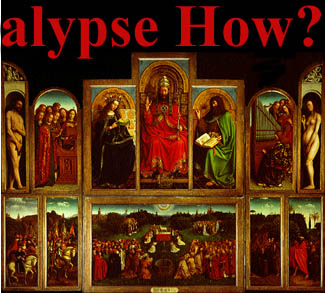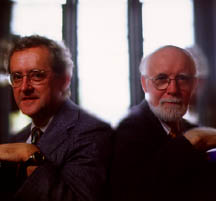 |
|
And
when? And why? And what's to be learned? Divinity School
professors Bernard McGinn and John Collins take an encyclopedic
approach to the end of the world.
|
 |
|
|
|
The Encyclopedia
of Apocalypticism—1,500 pages of religious scholarship that
analyze how, when, and why humans since pagan antiquity have felt
compelled to imagine the world’s end—was born in a decidedly non-apocalyptic
moment: over Irish whiskey at Kitty O’Sheas, a Michigan Avenue pub.
There, one afternoon during the November 1994 American Academy of
Religion conference, Divinity School professor Bernard McGinn sat
down with an editor from the appropriately named Continuum Publishing
Company. Their conversation turned to the hype over the year 2000
and the significant amount of apocalyptic scholarship amassed during
the past 30 years. The time was right, they agreed, if not for the
end of the world, then at least for a standard reference chronicling
its coming.
Known among
his colleagues as “Mr. Apocalypse” for his more than 20-year immersion
in the subject, McGinn enlisted as coeditors Divinity School professor
John J. Collins, an expert on the origins of apocalyptic beliefs,
and Indiana University’s Stephen J. Stein, a former president of
the American Society of Church History. Taking a chronological rather
than alphabetical approach to the project, they chose to focus on
Western Judeo-Christian traditions, with some discussion of Islam.
Published this
past summer, the Encyclopedia charts the evolution of apocalyptic
thought in three volumes of 43 original essays by 42 international
scholars. Their sober research does not make apocalyptic predictions,
seek to validate or disprove certain theories, or, as the Library
Journal noted in its favorable review, offer fodder “for fans
of UFOs, crop circles, or the re-emergence of Atlantis or Mu.” Rather,
the essayists strive to illuminate how societies have struggled
with apocalyptic notions and reflected them in art, literature,
political rhetoric, and popular culture.
“Apocalypticism
isn’t going to go away,” says Stein. “What has kept these traditions
so powerful is our inherent desire to know what the future will
bring. These are deep, rich, powerful traditions that have continued
for hundreds of years and are as powerful as they ever have been
as the end of the millennium draws near.”
 The
turn of a new millennium serves as a natural rallying point for
the apocalyptic faithful. Most current apocalyptic prophecies predict
the end’s arrival sometime between now and 2005, whether it’s marked
by Christ’s second coming, global tyranny, or natural disaster.
Though the word “millennium” can mean simply a span of 1,000 years,
for many people it invokes apocalyptic concerns, referring to the
1,000-year reign of Christ prophesied in the New Testament’s Book
of Revelation or to general cultural notions of a lengthy period
of perfection on earth. The
turn of a new millennium serves as a natural rallying point for
the apocalyptic faithful. Most current apocalyptic prophecies predict
the end’s arrival sometime between now and 2005, whether it’s marked
by Christ’s second coming, global tyranny, or natural disaster.
Though the word “millennium” can mean simply a span of 1,000 years,
for many people it invokes apocalyptic concerns, referring to the
1,000-year reign of Christ prophesied in the New Testament’s Book
of Revelation or to general cultural notions of a lengthy period
of perfection on earth.
“The year
2000 calls up issues of the meaning of history,” explains McGinn,
noting that the next 1,000-year period does not actually begin until
January 1, 2001. “The passage of the millennium has many people
thinking about whether the next millennium will bring a great crisis
in its early stage or a time of great human achievement.”
No wild-eyed
prophet himself, McGinn calls the millennial fever “overblown but
harmless,” and matter-of-factly says that “it’s a big mistake” to
read apocalyptic religious texts literally. Collins predicts that
“the world may well come to an end in the next 1,000 years, but
it will be the fault of humanity, not a divine plan.” And Stein
emphasizes his neutrality as a historian: “I’m not out to persuade
that some predictions are right and to debunk others.”
At the same
time, all three take their subject seriously. “These ideas are an
important part of history and still have power today,” says McGinn.
“It’s important to understand them and how to avoid their misuse.”
While every society weaves its own historical myths, he explains,
the three most prominent monotheistic religions—Judaism, Christianity,
and Islam—distinctly center on apocalyptic notions of a history
where God reveals himself at its beginning and its end. Without
an apocalyptic mentality, says Collins, “you wouldn’t have Christianity.”
Apocalypticism
thrived long before humanity faced the Y2K problem. Taken from the
ancient Greek apokalypsis—literally “an uncovering”—the word “apocalypse”
is defined by one standard English dictionary as “the expectation
of an imminent cosmic cataclysm in which God destroys the ruling
powers of evil and raises the righteous to life in a messianic kingdom.”
A more secular definition, writes Stein, generally refers to a “belief
in an imminent end to the present order, either through catastrophic
destruction and conflagration or through establishment of an ideal
society.”
While they
may differ in outcome, all apocalyptic tales comment on the future.
“There’s a very special temporal aspect to apocalyptic literature,”
says Divinity School professor Bruce Lincoln, who contributed an
essay on apocalyptic temporality. “It’s the sense of an immediate
future pressing on the present. It also expresses profound dissent
with the way things are.” Take the Book of Revelation, one of the
great apocalyptic touchstones. As Divinity School professor Adela
Yarbro Collins explains in her essay, the prophet John used symbolic
imagery and mythic language in Revelation both to comment on his
time and to transcend it. Through the story of a conflict between
a divine power and an evil beast, she says, John criticizes the
Roman emperor for fostering a growing inequality among his people.
Though some readers may look for a literal historical blueprint
in John’s writings, she argues that the texts are more truly symbolic
statements, full of details used primarily to make his rhetorical
points, just “as any artist would create a narrative vision.”
The typical
apocalyptic story, like Revelation, is one of good overcoming evil
in a dramatic, often violent struggle, with history culminating
in a day of individual or public judgment. “In apocalyptic literature,
religion is writ large,” says John Collins. “The supernatural overtones
are up front. Its powerful language and imagery provided the octane
in the fuel of early Christianity.”
Judaism, he
explains, first wove together and expanded the apocalyptic themes
of ancient cultures. The Torah borrows the idea of good versus evil
from Near Eastern combat myths, a moralizing tone from Persian myths
that envision a lasting division between light and dark, and a sense
of revelation from the Greeks and Romans, who presented a life beyond
this world. Judaism then adds angels, other netherworld emissaries,
and the idea that history is on a set course culminating in a resurrection
of the dead and a final day of judgment. Later, the Christians created
the expectation of Christ’s second coming, while the prophet Muhammad
made the goal of achieving justice on earth in preparation for the
coming judgment a central tenet of Islam.
Such dramatic
stories have provided inspiration for art and literature throughout
the centuries. “The phenomenon of the apocalypse is not just a matter
of theology but also of major cultural import,” says McGinn. Medieval
artisans, living in a time of church dominance and widespread epidemics,
produced some of the greatest works to capture the heightened sense
of doom and salvation found in the apocalypse. “Medieval folk lived
in a more or less constant state of apocalyptic expectation,” writes
McGinn, “difficult to understand for most of us today.”
In her Encyclopedia
essay, U of C art history professor Linda Seidel examines one of
the period’s most ambitious works. In the Ghent Altarpiece—a
group of painted panels dating to the 15th century in St. Bavo’s
Cathedral in Ghent, Belgium—Jan Van Eyck depicted the prophet John’s
earthly paradise, New Jerusalem, in a lush scene that includes at
its center a bleeding lamb surrounded by angels and other holy figures.
Van Eyck’s work, Seidel concludes, spurred viewers of the day to
meditate on John’s words, lending them plausibility with recognizable
human, plant, and architectural images. The altarpiece, like much
apocalyptic art, she says, seeks to construct a “visual sense of
forecast or foreboding, the mood and mode of apocalyptic writing
wherein present and future are ineluctably intertwined.”
While the 20th
century’s apocalyptic appropriations may not always rely on fire
and brimstone, they are no less ominous. The Encyclopedia
cites Cat’s Cradle (1963) by Kurt Vonnegut, AM’71, as an
example of “annihilative apocalypse” for its imagined ice-nine substance
that destroys life by freezing all the earth’s water. Then there’s
Stanley Kubrick’s classic film Dr. Strangelove: Or How I Learned
to Stop Worrying and Love the Bomb (1964) that, as Stephen D.
O’Leary of the University of Southern California writes, “demystified
the machineries of nuclear war and exposed the paradoxical absurdity
of the balance of terror.” Around the same time, O’Leary notes,
the rock band the Doors sang of violent passages to “the other side.”
In the 1990s, the Encyclopedia makes clear, apocalyptic rhetoric
has moved even further beyond the medieval priest’s pulpit: to the
Internet, where like-minded souls debate when the end will come;
to cable—witness televangelists like Jack Van Impe; and to the best-seller
lists, to which evangelical minister Pat Robertson’s The New
World Order—describing an Antichrist dictator aided by Jewish
bankers—ascended in 1991.
In its many
forms, apocalypticism has served many interests. The Encyclopedia
shows how it has provided hope for the oppressed, as when, during
their sixth-century Babylonian exile, the Jews drew strength from
biblical prophecy that their enemies would one day be overthrown.
For centuries, Christian church leaders have wielded apocalyptic
fears as a stick to encourage certain political and lifestyle changes
within the church government, clergy, and flock. During an 11th-century
campaign to restore moral purity to the clergy and church governance,
writes McGinn, Pope Gregory VII often warned that the need for change
became more important as the end drew nearer. Apocalypticism has
also provided an alternative religious framework. Stein chronicles
how, at the turn of the 19th century, German weaver and self-proclaimed
prophet George Rapp, along with 300 religious dissenters, founded
the pious Harmony Society to prepare for Christ’s second coming.
And contemporary scientists, the editors note, have employed apocalyptic
rhetoric to warn of the potential catastrophic consequences of global
warming, the AIDS epidemic, and nuclear war.
In the Encyclopedia’s
final, forward-looking essay, Divinity School professor emeritus
Martin Marty, PhD’56, notes the paradox of trying to ascertain the
future of a subject grounded in the idea that “the world as we know
it and time as we experience and reckon with it ultimately have
no future.” Marty suggests that there will always be a need for
such rhetoric as long as people are drawn to it through a sense
of duty-bound scriptural literalism, a need for mythopoeic fantasies,
or a desire to escape the present.
An apocalyptic
mentality may actually end up seeing us through the next millennium.
While some apocalyptic notions have been used to justify suicide
bombing and other destructive ends, John Collins maintains, the
overall effect of the apocalyptic impulse has been positive, providing
both “a store of hopeful imagery and the sense that problems will
eventually be overcome.”
|



